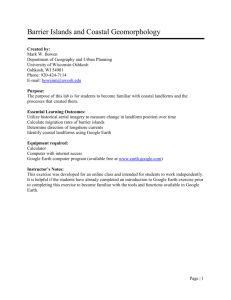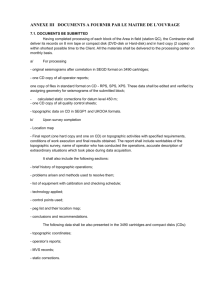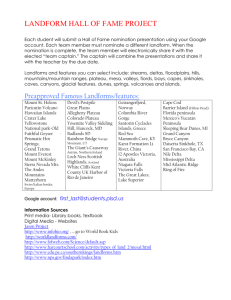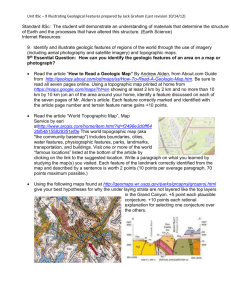Barriers Islands and Coastal Geomorphology Created by: Mark W
advertisement
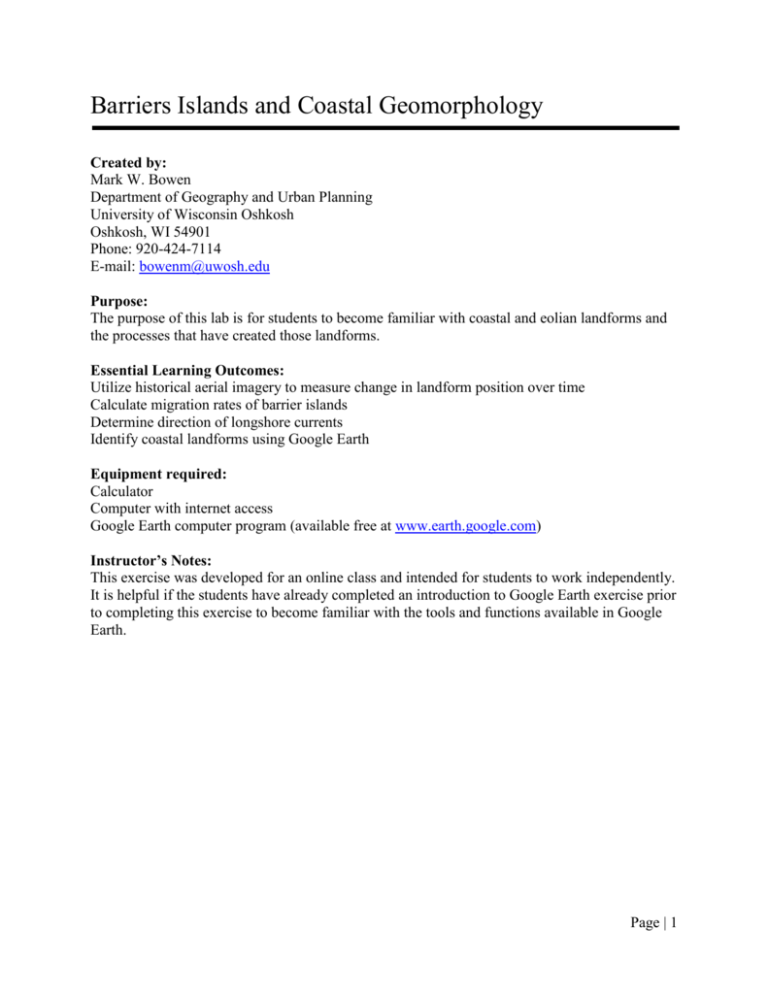
Barriers Islands and Coastal Geomorphology Created by: Mark W. Bowen Department of Geography and Urban Planning University of Wisconsin Oshkosh Oshkosh, WI 54901 Phone: 920-424-7114 E-mail: bowenm@uwosh.edu Purpose: The purpose of this lab is for students to become familiar with coastal and eolian landforms and the processes that have created those landforms. Essential Learning Outcomes: Utilize historical aerial imagery to measure change in landform position over time Calculate migration rates of barrier islands Determine direction of longshore currents Identify coastal landforms using Google Earth Equipment required: Calculator Computer with internet access Google Earth computer program (available free at www.earth.google.com) Instructor’s Notes: This exercise was developed for an online class and intended for students to work independently. It is helpful if the students have already completed an introduction to Google Earth exercise prior to completing this exercise to become familiar with the tools and functions available in Google Earth. Page | 1 Background: Coastal environments are highly dynamic landscapes that are slowly shaped by tidal action, waves, longshore currents, and the long-term rise and fall of sea level. Coastlines can also change dramatically during intense storm events such as tropical storms and hurricanes. Coastlines can expand oceanward (progradation) as deposition occurs, eroded landward (retrogradation), or migrate and change position and shape. Coastlines can be classified as either submergent or emergent. Submergent coastlines are those that have been inundated by water due to rising sea levels or sinking crust, while emergent coastlines are those that have become exposed due to falling sea levels or rising crust. Rias and fjords are examples of submergent coastlines; barrier island, delta, coral reef, volcanic, and fault coastlines are all emergent. Barrier island coastlines are the most common form in the United States, particularly along the Gulf Coast and East Coast where more than 300 barrier islands have been mapped. Barrier islands are long, narrow islands that parallel the coastline, typically only a few hundred feet or less offshore of the mainland. Barrier islands form where ridges of sand accumulate underwater from deposition by rivers and reworking by ocean currents. These ridges of sand become exposed and “emerge” from the ocean as sea levels fall or the landscape rises due to isostatic rebound. Barrier islands are highly mobile systems that constantly migrate and change position as the sand supply and forces acting upon them change. Historically, these islands were the first line of defense against large storm events, shielding the mainland from strong winds and waves. However, over time barrier islands have become highly developed with homes, condominiums, and other attractions, and damage to developments on these islands can be catastrophic during tropical storms and hurricanes. Due to construction and other activities that damage the vegetation and destabilize the sand deposits, most barrier islands are currently in a retrogradational phase, and the ability of barrier islands to reduce the impacts of major storm events has been diminished. Exercises: Part 1 – Barrier Island Evolution and Migration Fly to Brigantine Inlet, NJ in Google Earth and adjust eye altitude to approximate 5,000 feet. Hover the pointer over the following coordinates 39.447777 °N, 74.3280 °W or enter the coordinates into the search window to place a marker. Make sure the June 1, 2011 image is visible. If it is not, turn on the historical imagery slider by clicking on the “Show historical imagery button above the View panel (it looks like a clock with a blue arrow), and adjust the slider to June 1, 2011. 1. What type of landform is visible in this image at the above coordinates? spit Page | 2 Scroll the image to Pullen Island on the north side of the inlet. Adjust the historical imagery to 4/6/1995 and zoom to the south end of Pullen Island at an eye altitude of approximately 1,000 feet. Insert a Placemark precisely along the shoreline at the southernmost tip of the island; name the Placemark “South Pullen 1”. Adjust the historical imagery to 2/24/2013 and insert a Placemark precisely along the shoreline at the new location of the southernmost tip of the island; name the Placemark “South Pullen 2”. Use the ruler tool to measure the distance between the two Placemarks. 2. How far did the shoreline migrate between the two images, round to the nearest 10 feet? 660 feet 3. What was the approximate migration rate in feet/year? (Tip: To calculate migration rate, divide the distance by the amount of time that elapsed) Migration rate (ft/year) = 660 feet / 18 years = 36.67 feet/year 4. If migration rate stayed the same for the next 5 years, approximately how far will it have migrated? Distance = 36.67 feet/year * 5 years = 183.33 feet Load the Historical Topographic Maps layer and the USGS Topographic Maps layer from the Earth Gallery. To load these layers, click on the “Earth Gallery” button in the top right-hand corner of the Layers panel. This will open a browser window with a series of Google Earth files. Search for “topographic maps”. Click on the “USGS Topographic Maps” icon, and then click on the “View in Google Earth” button below the right-hand corner of the map. You can save the file to your computer and open it with Google Earth, or you can select “Open with”, click on the browse button, and select Google Earth. Click Ok and the “USGS Topographic Maps” layer should appear at the bottom of the Layers list. Repeat these steps to load the “Historical Topographic Maps” layer. Turn on the Historical Topographic Maps layer, adjust the eye altitude to ~10,000 feet, and zoom to the north end of Pullen Island at Little Egg Inlet. Insert a Placemark along the shoreline at the northern tip of the island; name the Placemark “Pullen north 1”. Turn off the Historical Topographic Maps layers and turn on the USGS Topographic Maps layers. Insert a Placemark along the shoreline at the northern tip of the island; name the Placemark “Pullen north 2.” Page | 3 Zoom out to an eye altitude of ~12 miles and turn on the “Information” layer for the Historical Topographic Maps and click on the purple icon that appears. Turn of the information for the historical topographic maps and turn on the information for the USGS Topographic Maps. 5. What are the years for the historical topographic map and USGS topographic map? 1994 and 2011 Using the ruler tool, measure the distance between Pullen north 1 and 2 Placemarks. 6. How far did the shoreline migrate between the two maps, round to the nearest 50 feet? 2,650 feet 7. What was the approximate migration rate in feet/year for Pullen Island? Migration rate = 2,650 feet / 17 years = 155.9 feet/year 8. If the migration rate stayed the same, how long would it take the northern tip of Pullen Island to migrate 1 mile? (Tip 1 mile = 5,280 feet) Time = 5,280 feet / 155.9 feet/year = 33.87 years 9. What is the direction of the longshore current from Brigantine Inlet to Little Egg Inlet? south to north Open the ruler tool and select the Path function. On the Historical Topographic Maps layer, outline/trace the eastern shoreline of Pullen Island from the southernmost tip to the northernmost tip. Save the measurement as “Pullen shoreline 1994”. Repeat for the USGS Topographic Maps layer, saving the measurement as “Pullen shoreline 2011. 10. Based on the topographic maps, from 1994 to 2011 did Pullen Island experience progradation or retrogradation? retrogradation Page | 4 Part 2 – Coastal Landform Identification in Google Earth Using Google Earth, enter the latitude and longitude (copy and paste is easiest) for the following locations. Examine each image at the altitude indicated (eye alt in lower right hand corner of Google Earth). To adjust image altitude hold Shift + Ctrl + Up/Down arrow. Adjusting the direction (Shift + Left/Right arrow) and tilt (Shift + Up/Down arrow) may help in identification. Additionally, the Photos or Historical Topographic Maps layers may aid in landform identification. For each site, identify the landform and location (State or Country). Below is the list of possible landforms. Each should only be used once. Barrier island Spit Estuary Sea stacks Pocket beach Tidal marsh Fjord Atoll Ebb/Flood delta Delta # Latitude Longitude Altitude Landform 11 37.659982° -76.158251° 200 – 300 mi Estuary Location (State or Country) Maryland 12 35.189739° -75.755406° 10 – 12 mi Ebb/Flood delta North Carolina 13 35.216276° -75.532569° 8,000 – 10,000 ft Spit North Carolina 14 29.822394° -93.573475° 20 – 40 mi Tidal marsh Louisiana 15 26.289858° -97.202398° 40 – 50 mi Barrier island Texas 16 30.877164° 31.232835° 300 – 400 mi Delta Egypt 17 71.122935° -25.017269° 200 – 300 mi Fjord Greenland 18 18.111206° -65.400852° 4,000 – 6,000 ft Pocket beach Puerto Rico 19 16.816390° -87.791619° 30 – 40 mi Atoll Belize 20 45.884084° -123.968457° 2,000 – 3,000 ft Sea stack Oregon Page | 5
